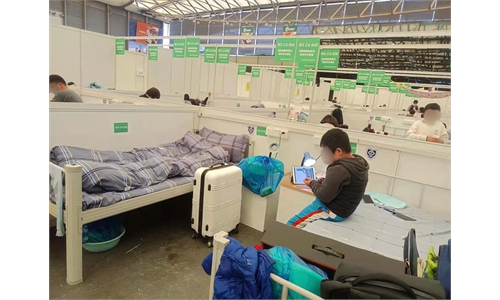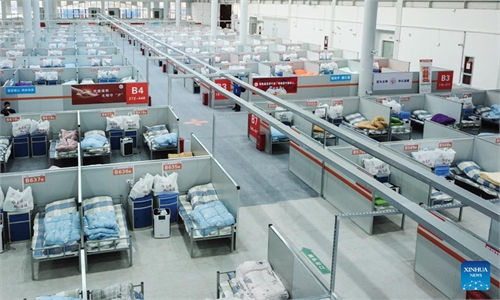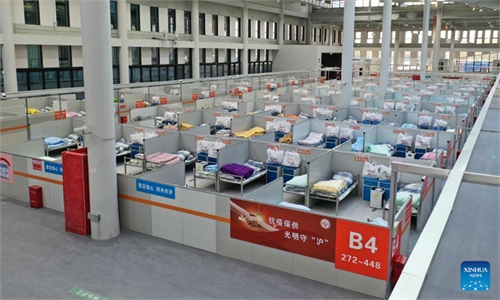Shanghai fights decisive battle against Omicron with swifter actions; nearby cities provide 60,000 beds for quarantine
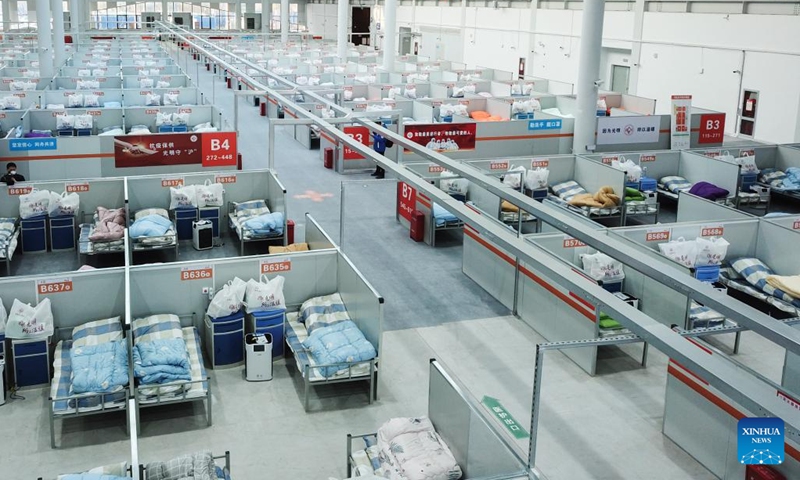
A makeshift hospital in Chongming of Shanghai Photo: Xinhua
The decisive battle against Omicron in Shanghai has entered a crucial stage, with the chief Chinese financial center conducting a second round of citywide nucleic acid testing on Wednesday, as new infections continued to hit a new record, striking the nerves of the whole country in the beginning of April.
During the past 36 hours, which was supposed to be a precious holiday for local residents to embrace the spring, a race to conduct nucleic acid tests for almost 25 million people was under way in every street and apartment complex in Shanghai. The goal is to fight it as fast as possible and contain the virus spread in the shortest possible time.
Top authorities in Shanghai called for a "firmer" attitude, "more thorough" measures and "swifter" actions in the battle against the faster and highly transmissible variant at a meeting held on Wednesday morning.
Shanghai Party chief Li Qiang vowed to speed up the process of collecting, sending, checking, reporting and verifying samples. "We must act as fast as we can to catch up with the positive cases and locate the infected people," he said.
Having gone through all these dark days, with assistance from other provinces and regions, Shanghai has been gearing up to build makeshift hospitals and collective quarantine centers while vowing to take stronger measures to make sure sufficient daily supplies are available to the metropolis' residents.
There are only two days left before April 8, the second anniversary to mark Wuhan lifting its lockdown two years ago. Chinese people hope that with stronger virus detection means, more adequate personnel and equipment, and increasingly pragmatic and dynamic control measures, Shanghai could fight against Omicron and emerge more resilient than Wuhan was from the early dark hours in 2022.
More venues, more support
Shanghai reported 311 local symptomatic cases and 16,766 local asymptomatic cases, including 7,892 from Pudong, on Wednesday, the second day that the city recorded over 10,000 cases. Medical experts said that the outbreak in Shanghai is bigger than what Wuhan faced at the height of the epidemic.
Shanghai officials said at Wednesday's press conference that since infections remain at high levels, the city will be put under lockdown again, and residents in different districts will have to undergo nucleic acid testing or rapid antigen tests. In other words, positive patients found in the previous screening will be transferred to the hospitals and screened again.
Chinese Vice Premier Sun Chunlan on Tuesday urged Shanghai to ratchet up the building of makeshift hospitals, expand quarantine venues and strictly follow the guidelines in order to defeat the COVID-19.
After a nine-hour overnight effort, the 8,500-square-meter office space of Shanghai New International Expo Center was transformed into a makeshift hospital and officially delivered at 9:00 am on Wednesday.
So far, over 10 designated hospitals and makeshift hospitals have been operational in Shanghai. The Global Times calculated based on incomplete statistics that at least 79,600 beds have been set up to meet the rising case numbers.
The National Exhibition and Convention Center is under construction to be converted into a makeshift hospital with a planned capacity of 40,000 beds. It is expected to be the largest makeshift hospital of its kind to receive patients with mild symptoms and asymptomatic patients.
Shanghai has also improved care services for COVID-19 infected children and will allow their parents to accompany them when receiving treatment, a move to provide better psychological care for children, after the debate on how infected children should be treated has sparked controversy online.
Under the new policy, for infected children who have special needs, their legal guardians can apply voluntarily to accompany them after signing an informed commitment. The Global Times learned from a working staff in the children quarantine bloc in the Shanghai New International Expo Center that about 400 minors aged between 2 and 18, in the company of their parents, are all in stable condition.
With the COVID-19 epidemic developing rapidly and prevention and control work at a critical stage, 38,000 medical workers from 15 provinces across China have been dispatched to support Shanghai, with the daily nucleic acid testing capacity reaching 2.38 million tubes, according to the information from National Health Commission officials on Wednesday.
The Global Times learned from a hospital staff member in Shanghai that several hotels in Hangzhou, a city about 170 kilometers away from Shanghai, have started to receive contacts and sub-contacts of COVID-19 patients from Shanghai for quarantine.
Jiangsu and Zhejiang, the two provinces neighboring Shanghai, have provided 37,000 quarantine rooms to aid Shanghai's battle against the resurgence and an additional 23,000 rooms are being prepared, according to Shanghai epidemic control authority.
Xu Chunrong, head of the Xingdao Impression Hotel in Qiandao Lake, Hangzhou, told the Global Times on Wednesday that the hotel began receiving quarantined people from Yuhang district in Hangzhou in March. From Tuesday, close contacts from Shanghai have been transferred to the hotel.
"We have received about 70 people transferred from Shanghai," a working staff from another Hangzhou-based hotel, which can accommodate around 100 guests in ordinary times, told the Global Times on Wednesday on condition of anonymity. But he did not know specific information about whether they are close contacts of confirmed COVID-19 patients.
"The local authorities will prepare catering for these people and we are responsible for providing related services such as delivering food for them, and there is also a special medical team for their medical needs" the staff said.
Apart from Hangzhou, an official surnamed Zhu from the epidemic prevention and control headquarter in Hanjiang district in Yangzhou, about 400 kilometers from Shanghai, told the Global Times on Wednesday that three hotels in the district have been prepared to be used as quarantine sites for positive infections or close contacts of COVID-19 infections that will be transferred from Shanghai.
An official surnamed Shi from Shanghai's Jing'an district also confirmed with the Global Times that a number of confirmed patients' close contacts will be transferred to many cities in adjacent Jiangsu and Zhejiang provinces.
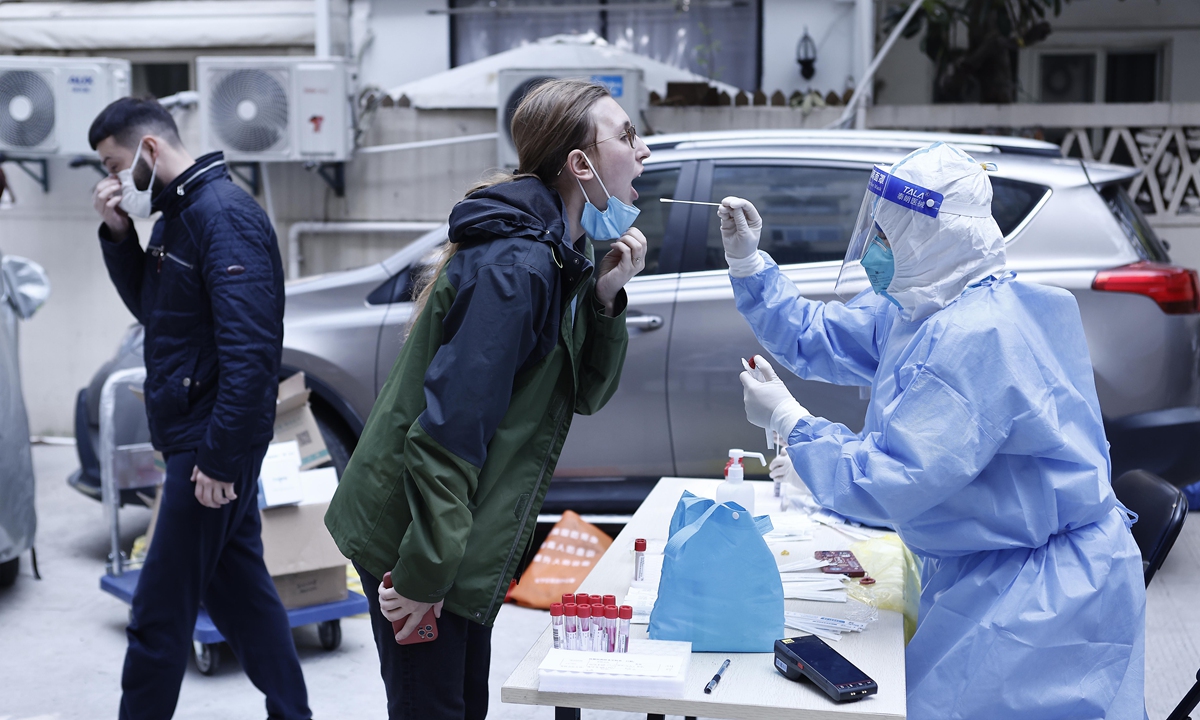
A foreign resident in Shanghai gets her sample taken for nucleic acid testing on April 6, 2022. Photo: cnsphoto
What is the next focus?
At Wednesday's press conference, Mi Feng, spokesperson of the National Health Commission, said China will continue to adhere to the dynamic zero-COVID policy unswervingly, and will enhance efforts to test, hospitalize, quarantine and treat people of corresponding needs in key areas.
Zhang Boli, an academician from the Chinese Academy of Engineering and head of the Tianjin University of Traditional Chinese Medicine, told media that we should, in particular, overcome the misperception that "epidemic prevention effort is excessive" and that "as the severe illness rate and death rate are low, there is no need to mobilize the public."
An article published by Jiefang Daily, also translated as Liberation Daily, the official daily newspaper of the Shanghai Municipal Committee of the Communist Party of China, on Wednesday, has also gone viral online, in which it said the central government has instructed Shanghai to be resolute and to act quickly and forcefully.
"There is no reason why we should not be more courageous in our responsibility. There is no reason why we should not do our best to help our people out. There is no reason for any more prevarication or delay or evasion," read the article.
"In the early days, quarantine centers in Shanghai faced problems with a shortage of medical and logistical personnel and local residents were scrambled for getting vegetables and food. But things have been better. Shanghai is able to overcome the difficulties with a firmer attitude and stronger measures, but the city has never 'lain flat,'" Tao Lina, a Shanghai-based medical observer, told the Global Times on Wednesday.
Lu Hongzhou, head of Shenzhen's anti-epidemic expert team and head of the Third People's Hospital of Shenzhen in South China's Guangdong Province, said that because the strain is Omicron, the scale of the outbreak in Shanghai is larger than that in Wuhan, but the severity of the disease is lower.
"This situation will not destroy Shanghai's medical resources, but it will certainly pose a huge challenge to the city's human resources. However, China has a unique institutional advantage. Whenever there is a shortage of medical resources in one place, neighboring provinces and cities can respond quickly to assist in the construction and operation of makeshift hospitals," Lu said.
Lu believes that after Shanghai completes nucleic acid testing for all personnel and screens out potential infected persons in eight days, the city could basically have contained the Omicron after a seven-day observation period.
"Wuhan and Shanghai, located in the middle reach and end of the Yangtze River, share the same water. It will not take long for Shanghai to walk out of the early dark hours and embrace bright normalcy," said a Wuhan resident.

